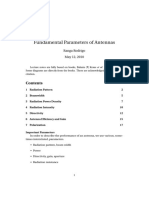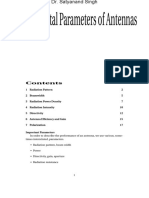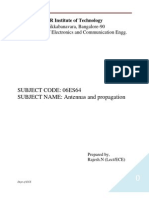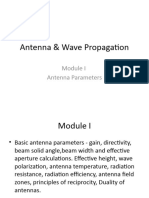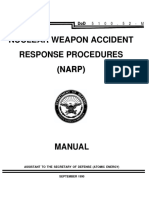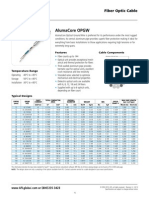Fundamental Parameters of Antenna
Fundamental Parameters of Antenna
Uploaded by
ihab411Copyright:
Available Formats
Fundamental Parameters of Antenna
Fundamental Parameters of Antenna
Uploaded by
ihab411Original Description:
Copyright
Available Formats
Share this document
Did you find this document useful?
Is this content inappropriate?
Copyright:
Available Formats
Fundamental Parameters of Antenna
Fundamental Parameters of Antenna
Uploaded by
ihab411Copyright:
Available Formats
Fundamental Parameters of Antennas
Ranga Rodrigo
May 12, 2010
Lecture notes are fully based on books, Balanis [?] Kraus et al. [?], and Rao [?].
Some diagrams are directly from the books. These are acknowledged by inserting the
citation.
Contents
1 Radiation Pattern 2
2 Beamwidth 5
3 Radiation Power Density 7
4 Radiation Intensity 10
5 Directivity 12
6 Antenna Efciency and Gain 15
7 Polarization 17
Important Parameters
In order to describe the performance of an antenna, we use various, some-
times interrelated, parameters.
Radiation pattern, beam width
Power
Directivity, gain, aperture
Radiation resistance
1
1 Radiation Pattern
Denition 1 (Antenna Radiation Pattern). An antenna radiation pattern or an-
tenna pattern is dened as a mathematical function or a graphical representa-
tion of the radiation properties of the antenna as a function of space coordi-
nates.
Dened for the far-eld.
As a function of directional coordinates.
There can be eld patterns (magnitude of the electric or magnetic eld)
or power patterns (square of the magnitude of the electric or magnetic
eld).
Often normalized with respect to their maximum value.
The power pattern is usually plotted on a logarithmic scale or more com-
monly in decibels (dB).
rd
d
dA
x
y
z
Radiation patterns are conveniently represented in spherical coordinates. Pat-
tern: E(, ).
d A =r
2
sindd.
Azimuth: Elevation: /2.
2
All three patterns yieldthe same angular separationbetweenthe twohalf-
power points, 38.64
, on their respective patterns, referred to as HPBW.
Radiation Pattern Lobes
A radiation lobe is a portion of the radiation pattern bounded by regions of
relatively weak radiation intensity.
Main lobe
Minor lobes
Side lobes
Back lobes
3
Minor lobes usually represent radiation in undesired directions, and they
should be minimized. Side lobes are normally the largest of the minor
lobes.
The level of minor lobes is usually expressed as a ratio of the power den-
sity, often termed the side lobe ratio or side lobe level.
In most radar systems, low side lobe ratios are very important to mini-
mize false target indications through the side lobes (e.g., -30 dB).
Components in the Amplitude Pattern
There would be, in general, three electric-eld components (E
r
, E
, E
) at
each observation point on the surface of a sphere of constant radius.
In the far eld, the radial E
r
component for all antennas is zero or van-
ishingly small.
Some antennas, depending on their geometry and also observation dis-
tance, may have only one, two, or all three components.
Ingeneral, the magnitude of the total electric eldwouldbe |E| =
_
|E
r
|
2
+|E
|
2
+|E
|
2
.
Isotropic, Directional, and Omnidirectional Patterns
Denition2 (Isotropic Radiator). A hypothetical lossless antenna having equal
radiation in all directions.
Denition3(Omnidirectional Radiator). Anantenna having anessentially nondi-
rectional pattern in a given plane (e.g., in azimuth) and a directional pattern in
any orthogonal plane.
Denition 4 (Directional Radiator). An antenna having the property of radiat-
ing or receiving more effectively in some directions than in others. Usually the
maximum directivity is signicantly greater than that of a half-wave dipole.
4
2 Beamwidth
The beamwidth of an antenna is a very important gure of merit and of-
ten is used as a trade-off between it and the side lobe level; that is, as the
beamwidth decreases, the side lobe increases and vice versa.
The beamwidth of the antenna is also used to describe the resolution ca-
pabilities of the antenna to distinguish between two adjacent radiating
sources or radar targets.
Denition 5 (Half-Power Beam Width (HPBW)). In a plane containing the di-
rection of the maximum of a beam, the angle between the two directions in
which the radiation intensity is one-half value of the beam.
Denition 6 (First-Null Beamwidth (FNBW )). Angular separation between the
rst nulls of the pattern.
Resolution
The most common resolution criterion states that the resolution capabil-
ity of an antenna to distinguish between two sources is equal to half the
rst-null beamwidth(FNBW/2), whichis usually used to approximate the
HPBW.
That is, two sources separated by angular distances equal or greater than
FNBW/2 HPBW of an antenna with a uniform distribution can be re-
solved.
If the separation is smaller, then the antenna will tend to smooth the an-
gular separation distance.
5
Example 7. An antenna has a eld pattern given by
E() =cos
2
(), 0
90
.
Find the half-power beamwidth HPBW (in radians and degrees).
Example 8. The normalized radiation intensity of an antenna is represented by
U() =cos
2
() cos
2
(3), 0
90
, 0
360
.
Find the
1. half-power beamwidth HPBW (in radians and degrees).
2. rst-null beamwidth FNBW (in radians and degrees).
Radiation Pattern Due to a Hertzian Dipole Radiation Pattern Due to a Hertzian Dipole
Isotropic Omni-directional
Near- and Far-Fields
D
Reactive near-eld region
Radiating near-eld (Fresnel) region
Far-eld (Fraunhofer) region
R
1
R
2
D =Largest dimension of the antenna. R
1
=0.62
D
3
/, R
2
=2D
2
/
6
Denition 9 (Reactive Near-Field Region R < 0.62
D
3
/). The portion of the
near-eld region immediately surrounding the antenna wherein the reactive
eld (non-radiating eld) predominates.
Denition 10 (Radiating Near-Field (Fresnel) Region 0.62
D
3
/R <2D
2
/).
The region of the eld of an antenna between the reactive near-eld region and
the far-eld region wherein radiation elds predominate and wherein the an-
gular eld distribution is dependent upon the distance fromthe antenna. If the
antenna has a maximum dimension that is not large compared to the wave-
length, this region may not exist.
Denition 11 (Far-Field (Fraunhofer) Region 2D
2
/ R). The region of the
eld of an antenna where the angular eld distribution is essentially indepen-
dent of the distance from the antenna.
3 Radiation Power Density
x
y
z
, E
, H
, E
, H
a
r
, E
r
, H
r
Poynting Vector
The quantity used to describe the power associated with an electromag-
netic wave is the instantaneous Poynting vector dened as
W =E H, (1)
7
where
W = instantaneous Poynting vector (W/m
2
), a power density.
E = instantaneous electric-eld intensity (V/m).
H = instantaneous magnetic-eld intensity (A/m).
The total power crossing a closed surface
P =
s
W ds =
s
W nda.
where
P = instantaneous total power (W).
n = unit vector normal to the surface.
a = innitesimal area of the closed surface (m
2
).
z
xx
yy
n
da
S
Average Power Density
For applications of time-varying elds, it is desirable to nd the average
power density.
The average power density is obtained by integrating the instantaneous
Poynting vector over one period and dividing by the period.
For time-harmonic variations of the form e
j t
, we dene the complex
elds E and H which are related to their instantaneous counterparts E
and H by
E(x, y, z; t ) =Re[E(x, y, z)e
j t
],
H(x, y, z; t ) =Re[H(x, y, z)e
j t
].
8
Example 12. Show that
W
av
=
1
2
Re[E H
] (W/m
2
).
Hint: Use the identity Re[E] =
1
2
[Ee
j t
+E
e
j t
].
Average Radiated Power
The power density associated with the electromagnetic elds of an an-
tenna in its far-eld region is predominately real and will be referred to
as radiation density.
The average power radiated by an antenna (radiated power) can be writ-
ten as
P
rad
=P
av
=
s
W
rad
ds =
s
W
av
nda,
=
1
2
s
Re
_
E H
_
ds.
Power Pattern Versus Average Radiated Power
The power pattern of the antenna is the average power density radiated
by the antenna as a function of the direction.
The observations are usually made on a large sphere of constant radius
extending into the far eld.
9
In practice, absolute power patterns are usually not desired, but the per-
formance of the antenna is measured in terms of relative power patterns.
Three-dimensional patterns cannot be measured, but they can be con-
structed with a number of two-dimensional cuts.
Example 13. Determine the total radiated power, if the radial component of the
radiated power density of an antenna is given by
W
rad
= a
r
W
r
= a
r
A
0
sin
r
2
(W/m
2
),
where A
0
is the peak value of the power density.
4 Radiation Intensity
Steradian
One steradian is dened as the solid angle with its vertex at the center of
a sphere of radius r that is subtended by a spherical surface area equal to
that of a square with each side of length r .
10
Since the area of a sphere of radius r is A =4r
2
, there are 4sr ina closed
sphere.
Denition 14 (Radiation Intensity). Radiation intensity in a given direction is
dened as the power radiated from an antenna per unit solid angle.
The radiation intensity is a far-eld parameter.
It can be obtained by simply multiplying the radiation density by the
square of the distance.
U =r
2
W
rad
.
Total Radiated Power Using Radiation Intensity
The total power is obtained by integrating the radiation intensity over the
entire solid angle of 4. Thus
P
rad
=
Ud=
_
0
_
2
0
U sindd.
where dis the element of solid angle = sindd.
Example 15. Using the concept of radiation intensity, determine the total radi-
atedpower, if the radial component of the radiatedpower density of anantenna
is given by
W
rad
= a
r
W
r
= a
r
A
0
sin
r
2
(W/m
2
),
where A
0
is the peak value of the power density.
For anisotropic source the radiation intensity U will be independent of the
angles and , as was the case for W
rad
.
Example 16. What is the radiation intensity due to an isotropic source with a
total radiated power of P
rad
?
11
5 Directivity
Denition 17 (Directivity). The ratio of the radiation intensity in a given direc-
tion from the antenna to the radiation intensity averaged over all directions.
The average radiation intensity: total power radiated by the antenna di-
vided by 4.
Stated more simply, the directivity of a nonisotropic source is equal to the
ratio of its radiation intensity in a given direction over that of an isotropic
source.
D =D(, ) =
U(, )
U
0
=
4U(, )
P
rad
.
If the direction is not specied, the direction of maximumradiation intensity is
implied.
D
max
=D
0
=
U
U
0
=
U|
max
U
0
=
U
max
U
0
=
4U
max
P
rad
.
D = directivity (dimensionless)
D
0
= maximum directivity (dimensionless)
U =U(, ) = radiation intensity (W/sr)
U
max
= maximum radiation intensity (W/sr)
U
0
= radiation intensity of isotropic source (W/sr)
P
rad
= total radiated power (W)
Example 18. Determine the directivity and the maximum directivity, if the ra-
dial component of the radiated power density of an antenna is given by
W
rad
= a
r
W
r
= a
r
A
0
sin
r
2
(W/m
2
),
where A
0
is the peak value of the power density.
12
1. What is the directivity of an isotropic source?
2. What can you say about the directivity of any other source?
1. 1.
2. D
0
1, 0 <D D
0
.
General Expression of Directivity
Radiation in tensity of an antenna:
U =B
0
F(, )
1
2
_
E
0
(, )
2
+
E
0
(, )
2
_
.
where
B
0
=a constant,
E
0
, E
0
=far-zone electric eld components,
=
_
0
120.
P
rad
=B
0
_
2
0
_
0
F(, ) sindd.
Directivity:
D(, ) =
U(, )
U
0
=
4U(, )
P
rad
=
4F(, )
_
2
0
_
0
F(, ) sind
.
Maximum directivity:
D
0
==
4
F(, )
max
_
2
0
_
0
F(, ) sind
.
BeamSolid Angle
Denition 19 (Beam Solid Angle). The beam solid angle
A
is dened as the
solid angle through which all the power of the antenna would ow if its radia-
tion intensity is constant (and equal to the maximum value of U) for all angles
within
A
.
13
P
rad
=
U
0
d,
=U
max
A
,
=4U
0
.
A
=
P
rad
U
max
,
=
_
2
0
_
0
F(, ) sindd
F
max
.
D =
4
A
.
Approximate Calculation of Directivity
Instead of using the exact expression
4
A
to compute the directivity, it is of-
ten convenient to use simpler but approximate expressions.
Kraus Tai and Pereira
Use when
1d
,
2d
>39.77
1d
,
2d
<39.77
In radians D
0
1r
2r
D
0
2
1r
+
2
2r
In degrees D
0
41253
1d
2d
D
0
72815
2
1d
+
2
2d
Example 20. The radiation intensity of the major lobe of many antennas can be
adequately represented by
U =B
0
cos,
where B
0
is the maximum radiation intensity. The radiation intensity exists
only in the upper hemisphere (0 /2, 0 2). Find the beam solid
angle: exact and approximate, maximum directivity: exact and approximate.
14
6 Antenna Efciency and Gain
The total antenna efciency e
0
is used to take into account losses at the
input terminals and within the structure of the antenna.
e
0
is due to the combination of number of efciencies:
e
0
=e
r
e
c
e
d
.
e
o
=total efciency,
e
r
=reection(mismatch) eff.,
=(1||
2
),
e
c
=conduction efciency,
e
d
=dielectric efciency,
=
Z
in
Z
0
Z
in
+Z
0
,
VSWR=
1+||
1||
.
= voltage reection coefcient at the input terminals of the antenna Z
in
=
antenna input impedance, Z
0
= characteristic impedance of the transmission
line. VSWR = voltage standing wave ratio
Usually e
c
and e
d
are very difcult to compute, but they can be deter-
mined experimentally.
It is usually more convenient to write e
0
as
e
o
=e
r
e
cd
=e
cd
(1||
2
).
where e
cd
= e
c
e
d
= antenna radiation efciency, which is used to relate
the gain and directivity.
Gain
The gain of the antenna is closely related to the directivity.
In addition to the directional capabilities it accounts for the efciency of
the antenna.
15
Gaindoes not account for losses arising fromimpedance mismatches (re-
ection losses) and polarization mismatches (losses).
Denition 21. Gain The ratio of the intensity, in a given direction, to the ra-
diation intensity that would be obtained if the power accepted by the antenna
were radiated isotropically.
Gain=4
radiation intensity
total input accepted power
=4
U(, )
P
in
(dimensionless).
We can write that the total radiated power (Prad) is related to the total
input power (Pin) by
P
rad
=e
cd
P
in
.
G(, ) =e
cd
_
4
U(, )
P
rad
_
G(, ) =e
cd
D(, ).
The maximum value of the gain is related to the maximum directivity
G
0
=e
cd
D
0
.
Absolute Gain
We can introduce an absolute gainG
abs
that takes into account the reec-
tion or mismatch losses (due to the connection of the antenna element to
the transmission line)
G
abs
=e
r
G(, ) =(1||
2
)G(, ) =e
r
e
cd
D(, ) =e
o
D(, ).
where
e
r
=(1||
2
), reection (mismatch) efciency,
e
o
=overall efciency.
If the antenna is matched to the transmission line, that is, the antenna
input impedance Z
in
is equal to the characteristic impedance Z
c
of the
line (|| =0), then the two gains are equal (G
abs
=G).
For the maximum values
G
0abs
=e
o
D
0
.
16
Example 22. A lossless resonant half-wavelength dipole antenna, with input
impedance of 73 ohms, is connected to a transmission line whose characteris-
tic impedance is 50 ohms. Assuming that the pattern of the antenna is given
approximately by
U =B
0
sin
3
.
nd the maximum absolute gain of this antenna.
Bandwidth
For broadband antennas, the bandwidth is usually expressed as the ratio
of the upper-to-lower frequencies of acceptable operation. For example,
a 10:1 bandwidth indicates that the upper frequency is 10 times greater
than the lower.
For narrowband antennas, the bandwidth is expressed as a percentage of
the frequency difference (upper minus lower) over the center frequency
of the bandwidth. For example, a 5% bandwidth indicates that the fre-
quency difference of acceptable operation is 5% of the center frequency
of the bandwidth.
7 Polarization
17
Denition23(Polarization). Polarizationis the curve tracedby the endpoint of
the arrow (vector) representing the instantaneous electric eld. The eld must
be observed along the direction of propagation.
Polarization is classied as linear, circular, or elliptical.
If the vector that describes the electric eld at a point in space as a func-
tion of time is always directed along a line, the eld is said to be linearly
polarized.
In general, the gure that the electric eld traces is an ellipse, and the
eld is said to be elliptically polarized.
x
y
z
P
o
l
a
r
o
i
d
E
Polarized
light
C
r
y
s
t
a
l
s
e
c
t
i
o
n
n
g
n
p Polarized
and de-
phased light
Polarization Types
Linear polarization and circular polarization are special cases of elliptic
polarization.
Polarization can be clockwise (CW, right-hand polarization), or counter
clockwise (CCW, left-hand polarization).
18
Linear, Circular and Elliptic Polarization
The instantaneous electric eld of a plane wave, traveling in the negative
z direction, can be written as
E(z; t ) = a
x
E
x
(z; t ) + a
y
E
y
(z; t ).
By considering the complex counterpart of these instantaneous compo-
nents, we can write
E
x
(z; t ) =E
xo
cos(t +kz +
x
),
E
y
(z; t ) =E
yo
cos(t +kz +
y
).
where E
xo
andE
yo
are the maximummagnitudes of the x- and y-components.
By dening =
y
x
, we can state these as
E
x
(z; t ) =E
xo
cos(t +kz),
E
y
(z; t ) =E
yo
cos(t +kz +).
Linear polarization
=n, n =1, 2, . . .
x
y
E
xo
E
yo
19
You might also like
- Fleet Oceanographic and AcousticDocument234 pagesFleet Oceanographic and Acousticihab41175% (4)
- CHAPTER 2 Single Phase Power Tutorial QuestionsDocument17 pagesCHAPTER 2 Single Phase Power Tutorial QuestionsFilbert OmbongiNo ratings yet
- Pages From Chapter 18-6Document10 pagesPages From Chapter 18-6taNo ratings yet
- Bishnu Hazra - Ece - Ec501-5thDocument20 pagesBishnu Hazra - Ece - Ec501-5thDevNo ratings yet
- Antenna ParametersDocument19 pagesAntenna ParametersSHANTANU B SNo ratings yet
- Antena - L2 - Antenna Parameters - Part122 - 23Document8 pagesAntena - L2 - Antenna Parameters - Part122 - 23مؤمل عبدالهاديNo ratings yet
- Antenna FundamentalsDocument24 pagesAntenna FundamentalskrupaNo ratings yet
- 2.2 Antenna ParametersDocument5 pages2.2 Antenna ParametersAdos OchiaNo ratings yet
- Fundamental Parameters of AntennasDocument19 pagesFundamental Parameters of AntennasLendry NormanNo ratings yet
- Lec 2Document24 pagesLec 2goraxi6015No ratings yet
- Properties of An AntennaDocument21 pagesProperties of An AntennaShankar BettadapuraNo ratings yet
- AntennaDocument340 pagesAntennadeepa reddyNo ratings yet
- Antenna ParametersDocument26 pagesAntenna ParametersBrhane DadsoNo ratings yet
- Antennas and Wave PropagationDocument107 pagesAntennas and Wave PropagationvivekanandaNo ratings yet
- AP Unit 1 Antenna Basics CompiledccjfgjcfjgghkDocument18 pagesAP Unit 1 Antenna Basics CompiledccjfgjcfjgghkVishal PurohitNo ratings yet
- Fundamental Antena Parameter BalanisDocument161 pagesFundamental Antena Parameter BalaniskukuhsatriowibowoNo ratings yet
- Chapter 2 Antenna ParametersDocument66 pagesChapter 2 Antenna Parameterstyoseph00No ratings yet
- Subject Code: 06es64 SUBJECT NAME: Antennas and PropagationDocument8 pagesSubject Code: 06es64 SUBJECT NAME: Antennas and PropagationShwetha B HegdeNo ratings yet
- AWP Unit 1Document81 pagesAWP Unit 1SRHNo ratings yet
- AntennaDocument45 pagesAntennaIndraysh Vijay [EC - 76]No ratings yet
- Chapter Two Fundamental Parameters of Antenna PDFDocument88 pagesChapter Two Fundamental Parameters of Antenna PDFAmare Kassaw100% (2)
- Unit2 Current Dist. Dipole Array 2024 ICTDocument66 pagesUnit2 Current Dist. Dipole Array 2024 ICTMitNo ratings yet
- Antennas: - Radiated Power - Radiation PatternDocument24 pagesAntennas: - Radiated Power - Radiation PatternMad ShahNo ratings yet
- 34 Aayushi Maurya A2 EXP 1 EMADocument9 pages34 Aayushi Maurya A2 EXP 1 EMAAayushi MauryaNo ratings yet
- Antenna 5Document30 pagesAntenna 5Frederico MailaNo ratings yet
- Fundamental Parameters of Antennas: 1. Radiation PatternDocument34 pagesFundamental Parameters of Antennas: 1. Radiation PatternTheBlindeadNo ratings yet
- FUNDAMENTAL PARAMETERS AND FIGURES-OF-MERIT OF ANTENNAS - ch2&ch1Document21 pagesFUNDAMENTAL PARAMETERS AND FIGURES-OF-MERIT OF ANTENNAS - ch2&ch1Abdelrahman Shaban - 53No ratings yet
- CH2 PDFDocument171 pagesCH2 PDFKfkf Franky100% (1)
- Lecture 09 - CIE 338 - Antenna Parameters (Final)Document23 pagesLecture 09 - CIE 338 - Antenna Parameters (Final)s-tasneem.attiaNo ratings yet
- Module 1 Fundamental Concept and Antenna ParameterDocument81 pagesModule 1 Fundamental Concept and Antenna ParameterU20EC131SANKALP PRADHAN SVNIT100% (1)
- "Faculty Development Program": Antenna Basics byDocument51 pages"Faculty Development Program": Antenna Basics byAmit JainNo ratings yet
- Ch7 - 3 Antennas3Document20 pagesCh7 - 3 Antennas3MasterArvinNo ratings yet
- Lectrure 2.basic Antenna ParametersDocument60 pagesLectrure 2.basic Antenna ParametersR Gowri ManohariNo ratings yet
- EC2353-Antenna and Wave PropagationDocument8 pagesEC2353-Antenna and Wave PropagationAlexander JagannathanNo ratings yet
- Antenna TerminologiesDocument13 pagesAntenna TerminologiesPramod BokdeNo ratings yet
- Wireless Communications: Mobile Radio Propagation: Large-Scale Path LossDocument57 pagesWireless Communications: Mobile Radio Propagation: Large-Scale Path Lossاعتزاز احمدNo ratings yet
- Antenna and Wave PropagationDocument43 pagesAntenna and Wave Propagationabinayaa.sNo ratings yet
- Antenna Radiation PatternDocument59 pagesAntenna Radiation PatternIdrees MohammedNo ratings yet
- Lecture44 EMFT Ashish GuptaDocument11 pagesLecture44 EMFT Ashish Guptatheuntamedguardianwoh159No ratings yet
- Antenna CharacteristicsDocument43 pagesAntenna CharacteristicsbalambikaNo ratings yet
- Fundamental Parametrs of AntennaDocument51 pagesFundamental Parametrs of AntennaIrum SabaNo ratings yet
- Anttna NotesDocument74 pagesAnttna NotesMo0od 0769No ratings yet
- Unit IDocument24 pagesUnit IKumar jiNo ratings yet
- Fundamental Parameters of Antenna (1) .PPSXDocument25 pagesFundamental Parameters of Antenna (1) .PPSXవేలుసామి లింగాసామిNo ratings yet
- Explain The Radiation From Two-Wire. Ans:: Unit 1Document13 pagesExplain The Radiation From Two-Wire. Ans:: Unit 1mohan inumarthiNo ratings yet
- 2 Marks With AnswerDocument9 pages2 Marks With AnswerMaha MurthyNo ratings yet
- Unit 2-S2Document26 pagesUnit 2-S2muditbisenk2004No ratings yet
- Ok! Solid Angle Antenna BasicsDocument32 pagesOk! Solid Angle Antenna BasicsMurangira AlbertNo ratings yet
- Chapter 1Document14 pagesChapter 1Varadharajan EswaramoorthiNo ratings yet
- Antenna ParametersDocument55 pagesAntenna ParametersAnwarshahin NKNo ratings yet
- Antenna TerminologyDocument14 pagesAntenna TerminologyMilan KumarNo ratings yet
- Unit 2 - Antennas and Wave Propagation - WWW - Rgpvnotes.inDocument27 pagesUnit 2 - Antennas and Wave Propagation - WWW - Rgpvnotes.invarun palNo ratings yet
- Unit 1: 1. Explain The Radiation From Two-Wire. AnsDocument13 pagesUnit 1: 1. Explain The Radiation From Two-Wire. AnsRajaganapathi RajappanNo ratings yet
- Unit 1: Short Question-Answers On Antennas and Wave Propagation Class-Ece Iii ADocument14 pagesUnit 1: Short Question-Answers On Antennas and Wave Propagation Class-Ece Iii Appk100% (1)
- Antenna BasicsDocument79 pagesAntenna BasicsshelleykdasNo ratings yet
- Ae Basics ShelleyDocument79 pagesAe Basics ShelleyshelleykdasNo ratings yet
- Antenna Lecture1Document63 pagesAntenna Lecture1Jhanzeb KhanNo ratings yet
- Intensity of Electromagnetic Waves as a Function of Frequency, Source Distance and Aperture AngleFrom EverandIntensity of Electromagnetic Waves as a Function of Frequency, Source Distance and Aperture AngleNo ratings yet
- Understanding Vector Calculus: Practical Development and Solved ProblemsFrom EverandUnderstanding Vector Calculus: Practical Development and Solved ProblemsNo ratings yet
- Feynman Lectures Simplified 2C: Electromagnetism: in Relativity & in Dense MatterFrom EverandFeynman Lectures Simplified 2C: Electromagnetism: in Relativity & in Dense MatterNo ratings yet
- Problems in Quantum Mechanics: Third EditionFrom EverandProblems in Quantum Mechanics: Third EditionRating: 3 out of 5 stars3/5 (2)
- Matrix RankDocument7 pagesMatrix Rankihab411No ratings yet
- Echelon Form of A MatrixDocument3 pagesEchelon Form of A Matrixihab411No ratings yet
- Syllabus EC760Document2 pagesSyllabus EC760ihab411No ratings yet
- Echelon Form of A MatrixDocument3 pagesEchelon Form of A Matrixihab411No ratings yet
- Radar Principles and SystemsDocument40 pagesRadar Principles and Systemsihab411No ratings yet
- Detector Characteristic For Decision-Directed Carrier Phase Recovery of 16 32-APSK SignalsDocument2 pagesDetector Characteristic For Decision-Directed Carrier Phase Recovery of 16 32-APSK Signalsihab411No ratings yet
- Detector Characteristic For Decision-Directed Carrier Phase Recovery of 16 32-APSK SignalsDocument2 pagesDetector Characteristic For Decision-Directed Carrier Phase Recovery of 16 32-APSK Signalsihab411No ratings yet
- Two-Dimensional (2D) Digital Signal Processing Examples: Radar Shadow Below The Washington MonumentDocument3 pagesTwo-Dimensional (2D) Digital Signal Processing Examples: Radar Shadow Below The Washington Monumentihab411No ratings yet
- An Introduction To Digital CommunicationsDocument70 pagesAn Introduction To Digital Communicationsihab411No ratings yet
- Nobel IdentitiesDocument6 pagesNobel Identitiesihab411No ratings yet
- ICDL For Educators Courseware - Using The Computer & Managing Files Module 2 Part 2Document46 pagesICDL For Educators Courseware - Using The Computer & Managing Files Module 2 Part 2ihab411No ratings yet
- Delay Line CancelerDocument41 pagesDelay Line Cancelergzb012No ratings yet
- SC8551A Datasheet Brief enDocument1 pageSC8551A Datasheet Brief enali tahaNo ratings yet
- US Department of Defense - Nuclear Weapon Accident Response ProceduresDocument211 pagesUS Department of Defense - Nuclear Weapon Accident Response ProceduresPamela Cooper100% (1)
- Baird, George - Energy Performance of buildings-CRC Press (1984)Document217 pagesBaird, George - Energy Performance of buildings-CRC Press (1984)Aymane KaraniNo ratings yet
- SupercapacitorsDocument20 pagesSupercapacitorsMohamed DRISSI100% (1)
- Chem 26 ReviewerDocument8 pagesChem 26 ReviewermattyrodrigoNo ratings yet
- Unit Code and Name: SPH 2202 - Thermal Physics IDocument5 pagesUnit Code and Name: SPH 2202 - Thermal Physics ISamuel BoujeeNo ratings yet
- Impact of DG On ProtecionDocument6 pagesImpact of DG On ProtecionAhmad AbunassarNo ratings yet
- AmoniaDocument35 pagesAmonianoelia cossio0% (1)
- For FinolexDocument72 pagesFor FinolexKokila KokilaNo ratings yet
- Nptel: High Voltage DC Transmission - Web CourseDocument2 pagesNptel: High Voltage DC Transmission - Web Coursekmd_venkatsubbu0% (1)
- Battery Charge 2Document94 pagesBattery Charge 2vishnu ANo ratings yet
- Evaluation of Vertical Kaplan Turbine Using CFD: Conference PaperDocument11 pagesEvaluation of Vertical Kaplan Turbine Using CFD: Conference PaperSayan KumarNo ratings yet
- Editorial and Resource StandardsDocument3 pagesEditorial and Resource StandardsjvanandhNo ratings yet
- Common Application FormDocument26 pagesCommon Application FormRamesh AnanthanarayananNo ratings yet
- CELMaharashtra 44 MWDocument81 pagesCELMaharashtra 44 MWGururaj KanjikerNo ratings yet
- Flue Gas System-2Document56 pagesFlue Gas System-2Sam100% (1)
- ENGGDocument63 pagesENGGrushikesh KanireNo ratings yet
- Petroleum and Natural Gas Regulatory Board NotificationDocument18 pagesPetroleum and Natural Gas Regulatory Board NotificationDebNo ratings yet
- Unit 4 EcosystemsDocument4 pagesUnit 4 Ecosystemsapi-332813379No ratings yet
- OPGW - AFL PRF Alumacore 2-15-12Document1 pageOPGW - AFL PRF Alumacore 2-15-12st0372724162No ratings yet
- Sanyo - SPW W366 606HH58Document38 pagesSanyo - SPW W366 606HH58GI CalbuthNo ratings yet
- Alasala Heat ExperimentDocument14 pagesAlasala Heat ExperimentbonnieNo ratings yet
- Class Notations Table - Jan14Document269 pagesClass Notations Table - Jan14shepeNo ratings yet
- IrtmtcDocument668 pagesIrtmtcnripinthampanNo ratings yet
- FEED Meadows Mediclinic Rooftop Solar PV PlantDocument1 pageFEED Meadows Mediclinic Rooftop Solar PV PlantBilal JavaidNo ratings yet
- WO AC ListDocument4 pagesWO AC ListCory PurbaNo ratings yet
- Layouts Oil and Gas Installations: Oil Industry Safety DirectorateDocument29 pagesLayouts Oil and Gas Installations: Oil Industry Safety DirectorateMugeshNo ratings yet
- 415 - Week 2 SlidesDocument5 pages415 - Week 2 SlidesHaphiz JusuNo ratings yet




